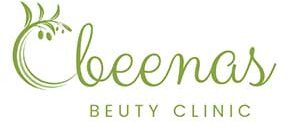Facial Hair Transplant Turkey: Complete Guide for 2025
Achieve the beard of your dreams with cutting-edge facial hair transplant procedures in Turkey. Discover world-class treatments at affordable prices.
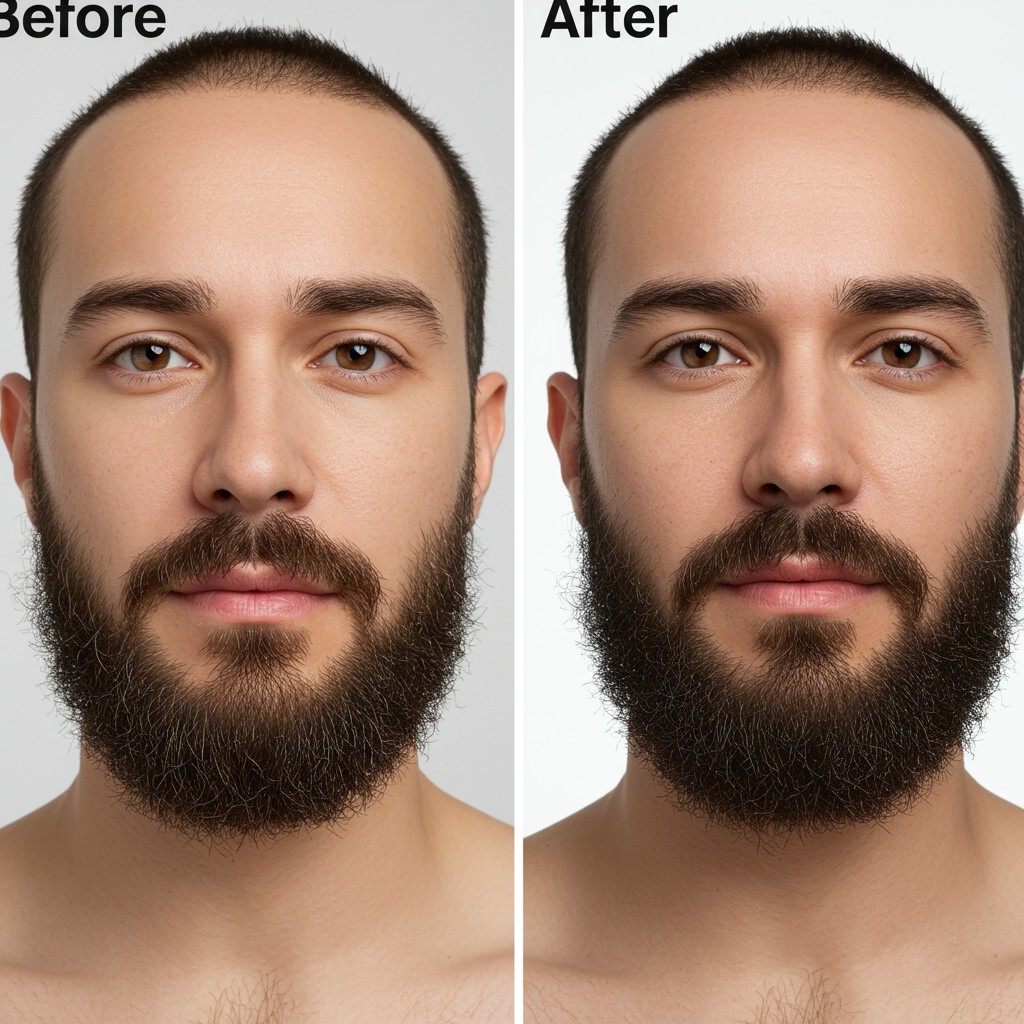
Dramatic before and after results of facial hair transplant procedure
For men who struggle with patchy, thin, or non-existent facial hair, a beard transplant in Turkey offers a permanent, natural-looking solution. Turkey has emerged as a global leader in hair restoration procedures, combining advanced techniques, experienced surgeons, and competitive pricing to attract thousands of international patients each year.
This comprehensive guide covers everything you need to know about facial hair transplantation in Turkey, from understanding the procedure and choosing the right technique to recovery expectations and long-term results.
Updated: April 2025
Dr. Beena Smith, MD
Hair Restoration Specialist
Table of Contents
What is Facial Hair Transplant? Ideal Candidates Transplantation Techniques The Procedure Step by Step Recovery and Timeline Costs and Packages Why Choose Turkey? Expected Results Celebrity Transformations Patient Testimonials Risks and Considerations Frequently Asked Questions Scientific ReferencesWhat is Facial Hair Transplant?
A facial hair transplant is a surgical procedure that involves extracting hair follicles from a donor area (typically the back of the head) and implanting them into specific areas of the face to enhance beard, mustache, sideburns, or other facial hair growth. The procedure uses the patient’s own hair follicles, ensuring natural-looking and permanent results.
While many men experience patchy or thin facial hair growth due to genetic factors, hormonal imbalances, or scarring, a facial hair transplant provides a solution by strategically placing hair follicles to create a fuller, more defined beard or facial hair pattern.
Types of Facial Hair Transplants
Beard Transplant
Enhances the fullness and coverage of the beard area, including cheeks, chin, and neck. Ideal for men with patchy beards or those unable to grow a full beard naturally.
Mustache Transplant
Focuses on adding density to the mustache area, creating a more prominent and well-defined upper lip appearance. Can also reconstruct the mustache after injury or scarring.
Sideburn Transplant
Restores or enhances sideburns, creating better facial framing and connecting beard and hair for a more complete look.
Goatee Transplant
Targets the chin and below the lower lip to create or enhance a goatee style, which can be a standalone feature or part of a larger beard design.
All these procedures follow similar principles but differ in the placement pattern and density required for natural-looking results in each specific facial region.
Ideal Candidates for Facial Hair Transplant
Not everyone is an ideal candidate for facial hair transplantation. The success of the procedure largely depends on several factors related to the individual’s health, donor hair quality, and expectations.
Who Can Benefit Most?
- Men with patchy beard growth due to genetic factors
- Individuals with facial hair loss from scarring, burns, or injuries
- Transgender men seeking to enhance masculine facial features
- Men with hormonal imbalances causing limited facial hair growth
- Those with realistic expectations about results and timeline
A good candidate should also be in generally good health and have sufficient donor hair available (typically from the back of the head) for harvesting.
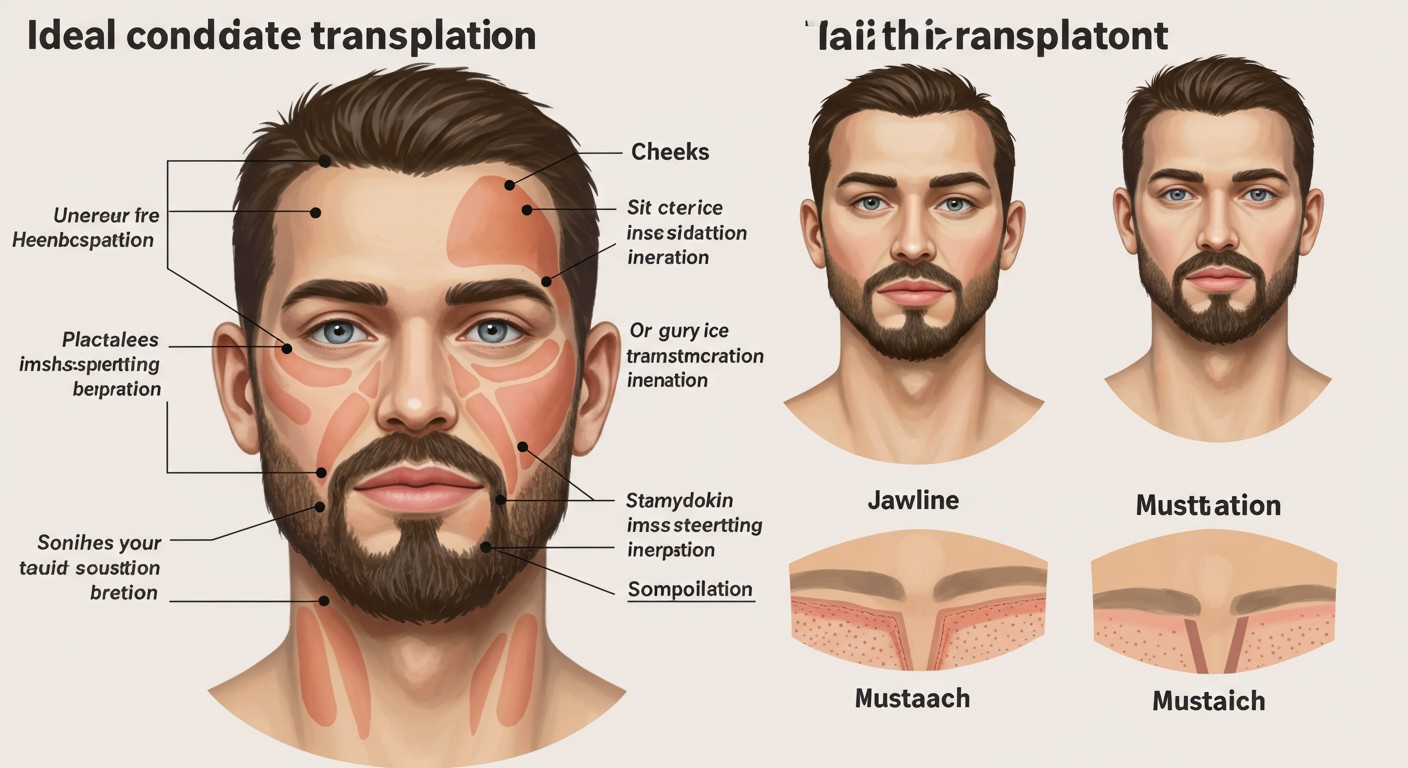
Medical illustration showing ideal areas for facial hair transplantation
Important Considerations
Before proceeding with a facial hair transplant in Turkey, candidates should consider:
- Age factor: Younger patients should understand that hair loss patterns may change over time
- Donor area limitations: The availability and quality of donor hair will affect the outcome
- Skin conditions: Active skin conditions like severe acne or psoriasis may complicate the procedure
- Lifestyle factors: Smoking can significantly impair healing and graft survival
- Medication review: Some medications may affect blood flow and healing
At Beena’s Beauty Clinic, we conduct thorough consultations to determine if you’re an ideal candidate for facial hair transplantation, ensuring the best possible outcomes for each patient.
Facial Hair Transplant Techniques
There are primarily two advanced techniques used for facial hair transplantation in Turkey: Follicular Unit Extraction (FUE) and Direct Hair Implantation (DHI). Each offers distinct advantages and may be recommended based on your specific needs and goals.
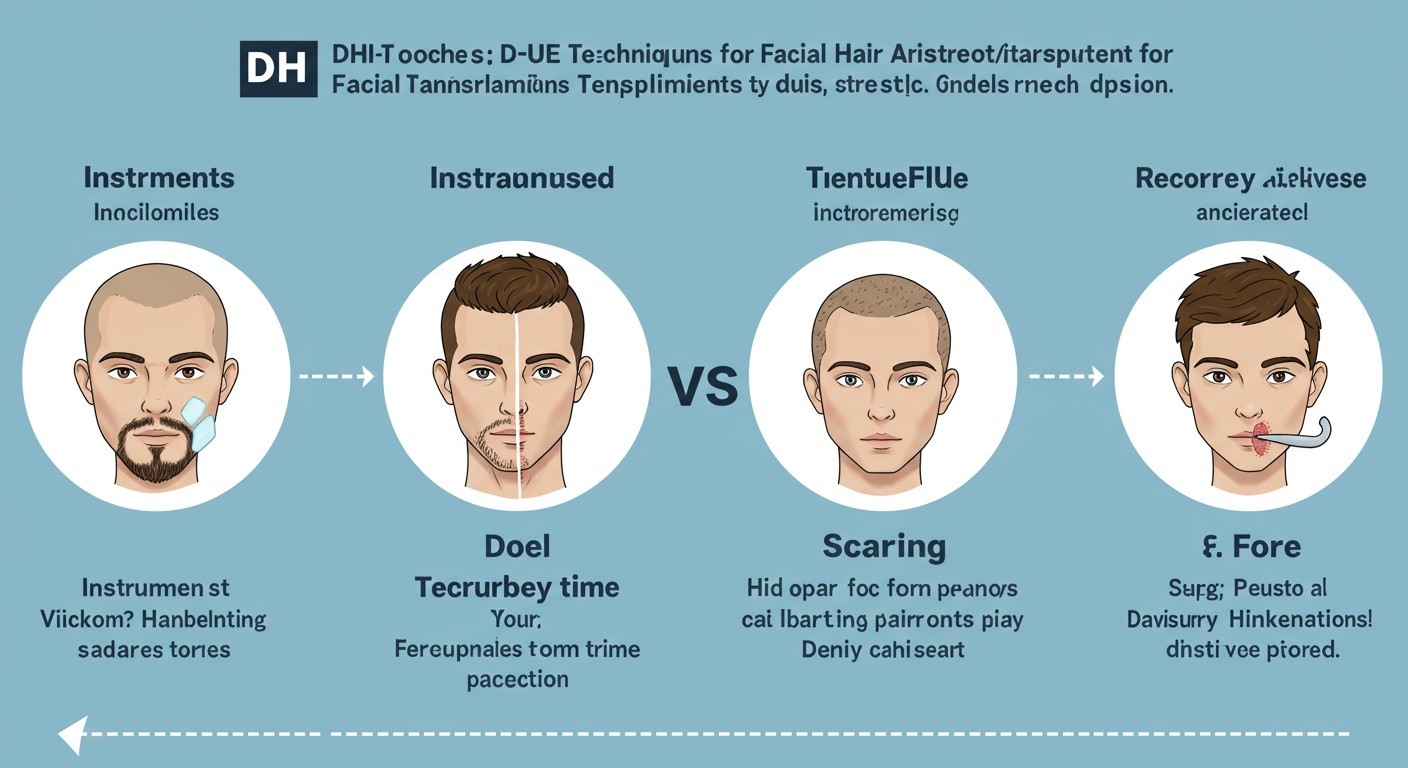
Detailed comparison of DHI and FUE techniques for facial hair transplantation
FUE is the most widely used technique for facial hair transplantation in Turkey. It involves:
- Extracting individual hair follicles from the donor area
- Creating tiny recipient sites in the facial area
- Implanting the extracted follicles into these sites
Advantages:
- Minimal scarring (tiny dot-like scars that are barely noticeable)
- Quicker recovery compared to older techniques
- Suitable for harvesting larger quantities of grafts
- More affordable than DHI
Best for: Patients requiring extensive coverage or those on a more limited budget
DHI is a more advanced technique that uses a specialized tool called a Choi implanter pen. The process involves:
- Extracting individual follicles from the donor area
- Loading them directly into the Choi implanter pen
- Implanting them directly into the facial area without creating channels first
Advantages:
- Greater precision in angle, direction, and depth
- Less trauma to the surrounding tissue
- Reduced risk of infection
- Quicker recovery time
- Higher density achievable
Best for: Patients seeking maximum density and precision, especially in mustache and goatee areas
Which Technique is Right for You?
The choice between FUE and DHI depends on several factors:
Density Requirements
DHI allows for higher density implantation, making it ideal for mustache areas where density is crucial.
Budget Considerations
FUE is generally more economical while still offering excellent results for most patients.
Recovery Timeline
DHI typically offers a slightly quicker recovery with less post-procedure downtime.
During your consultation at Beena’s Beauty Clinic, our specialists will assess your facial structure, existing hair patterns, and goals to recommend the most appropriate technique for your specific case.
The Facial Hair Transplant Procedure: Step by Step
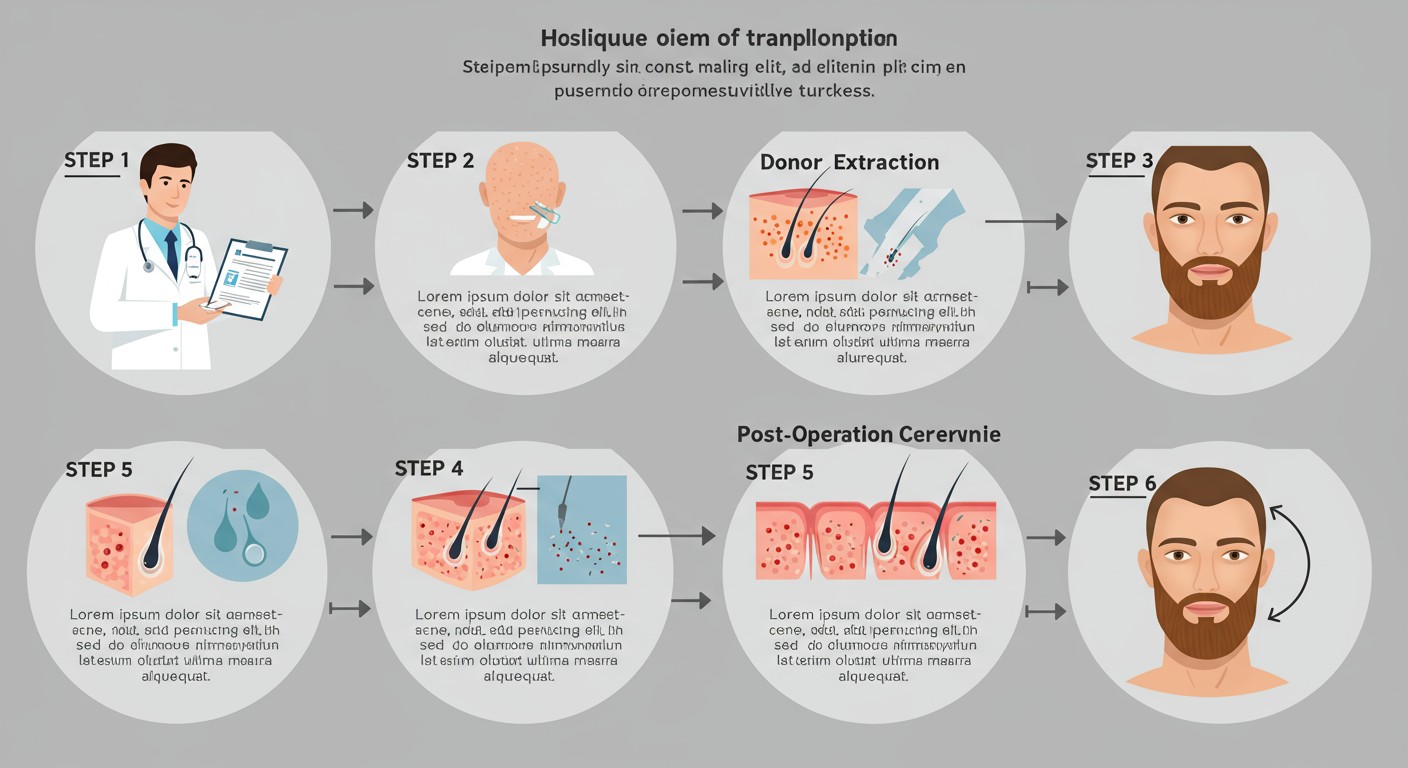
Comprehensive visualization of the facial hair transplant procedure from consultation to final results
Understanding what happens during each stage of a facial hair transplant can help alleviate concerns and set realistic expectations. Here’s a detailed breakdown of the entire process:
1. Initial Consultation
The journey begins with a thorough consultation, either in-person or online for international patients. During this consultation:
- Your current facial hair pattern is assessed
- Donor area availability is evaluated
- Your goals and expectations are discussed
- A customized treatment plan is formulated
- Technique selection (FUE or DHI) is recommended
Photos are taken for before/after comparison and to assist in planning the procedure.
2. Pre-Operation Preparation
On the day of the procedure:
- The donor and recipient areas are cleaned
- A blood test may be performed to ensure you’re fit for the procedure
- The surgeon marks the areas to be treated and designs the beard/facial hair pattern
- Local anesthesia is administered to both donor and recipient areas to ensure comfort
For most patients, the donor area hair is trimmed short to facilitate extraction.
3. Graft Extraction
During this phase:
- Individual hair follicles (grafts) are extracted from the donor area
- Each graft contains 1-3 hair follicles
- Micro-punches (typically 0.6-0.8mm) are used to minimize scarring
- Extracted grafts are carefully preserved in a special solution
For a full beard transplant, 2,000-4,000 grafts are typically extracted, depending on the coverage needed.
4. Recipient Site Creation
In FUE technique (this step is combined with implantation in DHI):
- Tiny incisions are made in the recipient area
- The surgeon carefully plans the angle, direction, and distribution of these sites
- Special attention is paid to creating a natural-looking hairline and growth pattern
This step requires artistic skill and understanding of natural facial hair growth patterns to achieve natural-looking results.
5. Graft Implantation
During implantation:
- The extracted grafts are carefully placed into the recipient sites
- With DHI, the Choi implanter pen inserts grafts directly
- Grafts are placed at specific angles to match natural growth patterns
- The distribution considers natural density variations across different facial regions
This meticulous process can take several hours, depending on the number of grafts being transplanted.
6. Post-Procedure Care
Immediately after the procedure:
- Both donor and recipient areas are cleaned
- Antibiotics and anti-inflammatory medications may be prescribed
- Detailed aftercare instructions are provided
- A follow-up appointment is scheduled
For international patients, most clinics in Turkey include a 2-3 night stay to monitor initial recovery before returning home.
The entire procedure typically takes 4-8 hours, depending on the extent of the transplant. Most patients describe the experience as comfortable, with minimal discomfort due to the effective local anesthesia used.
At Beena’s Beauty Clinic, we pride ourselves on creating a relaxed environment with experienced medical teams who specialize in facial hair transplantation, ensuring optimal results for each patient.
Recovery and Results Timeline
The recovery process after a facial hair transplant follows a predictable pattern, although individual experiences may vary. Understanding this timeline helps manage expectations and ensures proper care during each phase.
Recovery Timeline
Immediate Post-Procedure (Days 1-3)
- Mild swelling and redness in both donor and recipient areas
- Possible discomfort managed with prescribed medication
- Small crusts form around the implanted follicles
- Sleeping with head elevated is recommended
This is when most international patients typically remain in Turkey for monitoring.
First Week (Days 4-7)
- Swelling begins to subside
- Donor area starts healing
- Crusts remain on recipient area
- Itching may begin (but scratching must be avoided)
Most patients can return to non-strenuous work after 5-7 days.
Weeks 2-3
- Crusts naturally fall off
- Donor area healing completes
- Transplanted hairs begin to shed (this is normal and expected)
- The facial skin appears smoother
The shedding phase often causes concern, but it’s a normal part of the process.
Months 1-3 (Dormant Phase)
- Most transplanted hairs have shed
- Recipient area may appear similar to pre-procedure
- Hair follicles enter a resting phase
- Normal activities and exercise can resume
This is often called the “waiting phase” and requires patience.
Results Timeline
| Timeline | What to Expect | Care Instructions |
|---|---|---|
| Months 3-4 |
|
|
| Months 5-6 |
|
|
| Months 7-9 |
|
|
| 12-18 Months |
|
|
“The facial hair transplant journey requires patience, but the permanent results are worth the wait. Understanding that the initial shedding is normal and part of the process helps patients maintain realistic expectations during recovery.”
— Dr. Mehmet Yilmaz, Lead Surgeon at Beena’s Beauty Clinic Turkey
Post-Procedure Care Instructions
DO’s
- Sleep with your head elevated for the first week
- Use prescribed medications and washes as directed
- Keep the recipient area dry for the first 3 days
- Wash the transplanted area gently as instructed after day 3
- Protect the recipient area from direct sunlight for at least 3 months
- Follow the clinic’s specific aftercare guidelines
DON’Ts
- Don’t touch, scratch, or rub the recipient area
- Avoid strenuous physical activities for at least 2 weeks
- Don’t consume alcohol for at least 7 days
- Avoid smoking for at least 1 month (ideally quit completely)
- Don’t use regular shampoos on the recipient area until advised
- Don’t shave the transplanted area for at least 30 days
At Beena’s Beauty Clinic, we provide comprehensive aftercare support, including virtual follow-up consultations to ensure optimal healing and results, regardless of where you live.
Facial Hair Transplant Costs in Turkey
One of the primary reasons patients choose Turkey for facial hair transplantation is the significant cost advantage compared to Western countries, without compromising on quality or results.
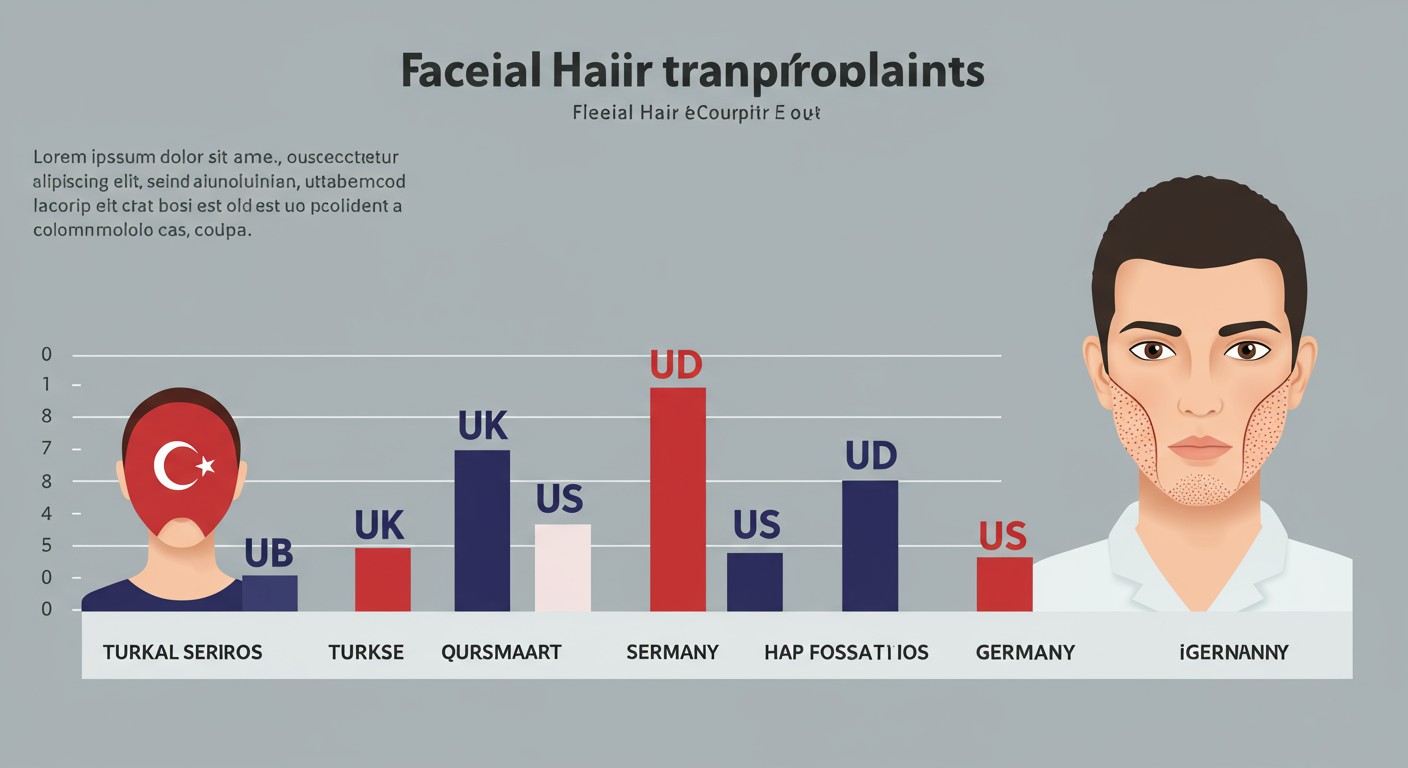
Price comparison of facial hair transplant procedures across different countries
2025 Price Comparison
| Country | Average Cost (USD) | What’s Typically Included |
|---|---|---|
| Turkey | $1,500 – $3,000 | All-inclusive packages with procedure, accommodation, transfers, aftercare |
| UK | $7,000 – $12,000 | Procedure only, additional costs for aftercare |
| USA | $8,000 – $15,000 | Procedure only, medications and follow-ups typically extra |
| Germany | $6,000 – $10,000 | Basic procedure, some aftercare included |
| Canada | $7,000 – $12,000 | Procedure only, follow-ups typically included |
Factors Affecting Pricing in Turkey
Number of Grafts
The primary pricing factor is the number of grafts required:
- Partial beard: 500-1,500 grafts
- Full beard: 2,000-4,000 grafts
- Mustache only: 350-700 grafts
- Sideburns: 200-500 grafts per side
Technique Used
Technique influences pricing:
- FUE: More affordable option
- DHI: Premium option, typically 20-30% higher
- Sapphire FUE: Mid-range pricing
Clinic Reputation & Location
Facility quality impacts cost:
- Premium Istanbul clinics: Higher pricing
- Experienced surgeons: Premium rates
- JCI-accredited facilities: Premium quality
All-Inclusive Packages at Beena’s Beauty Clinic
Basic Facial Hair Package
Ideal for partial beard or mustache restoration
$1,700
- Up to 1,500 grafts
- FUE technique
- 2 nights accommodation (3★ hotel)
- Airport-hotel-clinic transfers
- Basic aftercare kit
- Interpreter service
Premium Beard Package
Complete beard and mustache restoration
$2,350
- Up to 3,000 grafts
- Sapphire FUE technique
- 3 nights accommodation (4★ hotel)
- VIP airport-hotel-clinic transfers
- PRP treatment included
- Premium aftercare kit
- 12-month follow-up support
Elite DHI Package
Ultimate precision and density
$3,190
- Up to 3,500 grafts
- DHI premium technique
- 4 nights accommodation (5★ hotel)
- Luxury private transfers
- PRP + Stem Cell therapy
- Luxury aftercare package
- Lifetime follow-up support
Additional Services (Optional)
- Extended PRP Treatment: $250
- Additional Hotel Nights: $80/night
- City Tour Package: $150
- Companion Package: $300
All packages at Beena’s Beauty Clinic include a comprehensive pre-operative consultation to determine the exact requirements for your procedure. Financing options are also available for international patients.
Why Choose Turkey for Facial Hair Transplantation?
Turkey, particularly Istanbul, has emerged as a global hub for hair restoration procedures, attracting thousands of patients annually from Europe, the Middle East, and North America. This popularity isn’t merely due to affordable pricing but stems from a combination of several compelling factors:
Key Advantages of Turkey for Facial Hair Transplants
World-Class Medical Expertise
Turkish surgeons specializing in hair restoration have performed thousands of procedures, developing unparalleled expertise in the field. Many are internationally certified and train other surgeons globally.
Advanced Technology and Facilities
Leading clinics in Turkey feature state-of-the-art equipment and technologies that rival or exceed those found in Western countries, including the latest in DHI, Sapphire FUE, and other advanced techniques.
Comprehensive All-Inclusive Packages
Unlike in many Western countries where patients must arrange every aspect separately, Turkish clinics typically offer comprehensive packages that include accommodation, transfers, and aftercare—creating a hassle-free experience.
The Turkish Advantage by Numbers
Additional Benefits of Choosing Turkey
Quality Assurance
Many Turkish clinics are JCI-accredited (Joint Commission International), ensuring they meet rigorous international standards for quality and safety.
Patient-Centric Approach
Turkish clinics are renowned for their hospitality and personalized care, with dedicated coordinators who speak multiple languages to ensure seamless communication.
Medical Tourism Infrastructure
Istanbul, in particular, has developed robust infrastructure specifically for medical tourists, from specialized hotels to transportation services tailored to patients’ needs.
Combine Treatment with Tourism
Many patients choose to extend their stay in Turkey to enjoy its rich cultural heritage, making their facial hair transplant journey both a medical and cultural experience. Istanbul, where most premium clinics are located, offers:
Historic sites like the Hagia Sophia, Blue Mosque, and Topkapi Palace
World-renowned cuisine and culinary experiences
The famous Grand Bazaar for shopping enthusiasts
Scenic Bosphorus cruises offering unique perspectives of the city
At Beena’s Beauty Clinic, we help our patients make the most of their time in Turkey, offering guidance on cultural experiences that can comfortably be enjoyed during the recovery period.
Expected Results from Facial Hair Transplantation
Facial hair transplantation can dramatically transform your appearance, boosting confidence and creating the masculine look many men desire. Understanding what results to expect and when to expect them helps patients maintain realistic expectations throughout the journey.
What Results Can You Expect?
- Natural-looking facial hair that grows, feels, and behaves like natural beard hair
- Permanent results as the transplanted follicles come from DHT-resistant areas
- Ability to style, trim, and shave your new facial hair just like natural beard hair
- Enhanced facial definition and masculine features
- Improved symmetry and coverage in previously patchy or bare areas
- Gradual improvement over 12-18 months as transplanted hair thickens
The final results of a facial hair transplant should be virtually indistinguishable from natural facial hair, allowing you complete freedom in styling and grooming options.
Key Milestones in Results Timeline
Important Note About Results
Patient satisfaction with facial hair transplants depends greatly on having realistic expectations and understanding the gradual nature of the results. The final appearance continues to improve for up to 18 months post-procedure.
Factors That Influence Your Results
Surgeon’s Expertise
The artistic skill and technical expertise of your surgeon significantly impacts the natural appearance of your results. Experienced surgeons understand the natural angles and distribution patterns of facial hair.
Technique Used
DHI typically produces more precise angling and higher density, while FUE provides excellent coverage for larger areas. The choice of technique influences your final results.
Donor Hair Quality
The characteristics of your donor hair (thickness, color, curl pattern) will determine the appearance of your transplanted facial hair. This is why proper assessment is crucial.
Post-Procedure Care
Following aftercare instructions closely enhances graft survival rates and optimal results. Proper care during the first week is particularly crucial.
Individual Healing Factors
Genetic factors, age, overall health, and lifestyle habits (smoking, diet, exercise) can all influence how quickly and effectively you heal and the quality of your results.
Graft Survival Rate
While top clinics achieve 90-95% graft survival rates, some loss is normal. Additional sessions may be needed in some cases to achieve desired density.
Long-Term Considerations
Facial hair transplants provide permanent results, but there are some long-term considerations to keep in mind:
Transplanted hair may differ slightly in texture from your natural facial hair
As you age, your natural facial hair pattern may change, but transplanted hair remains stable
Maintaining a healthy lifestyle supports the longevity and appearance of your results
Some patients may desire a touch-up procedure after several years to enhance density
At Beena’s Beauty Clinic, we provide ongoing support throughout your journey, with follow-up consultations to monitor your results and offer guidance on maximizing your outcome.
Celebrity Facial Hair Transformations
The popularity of facial hair transplantation has been boosted by numerous celebrities who have undergone the procedure to enhance their appearance. While many celebrities are discreet about their cosmetic procedures, several high-profile figures are rumored or known to have had facial hair transplants, with Turkey being a popular destination.
Notable Celebrity Transformations
Sports Personalities
Several footballers and athletes have enhanced their facial hair appearance through transplantation, with Turkey being a preferred destination. The sudden appearance of fuller beards among previously sparse-bearded athletes has sparked public interest in the procedure.
Film & Television Stars
Actors often undergo facial hair transplants to maintain a youthful yet masculine appearance or to prepare for specific roles requiring fuller beards. The ability to grow a full beard has become an asset in the entertainment industry.
Public Figures & Influencers
With social media’s rise, many influencers have been open about their facial hair transplant journeys, documenting the process and results for their followers and increasing awareness about the procedure.
Why Celebrities Choose Turkey
-
Privacy and Discretion
Turkish clinics offer high-profile clients enhanced privacy protocols and discretion, allowing celebrities to undergo procedures away from public scrutiny.
-
VIP Treatment
Leading Turkish clinics provide luxury accommodations, private entrances, and personalized services tailored to high-profile clients’ needs.
-
Expertise with Public Figures
Many Turkish surgeons have extensive experience working with celebrities and understand their unique requirements for natural-looking results that won’t draw unwanted attention.
“The most successful celebrity facial hair transplants are the ones you don’t even notice. The natural results achieved by top Turkish clinics allow public figures to enhance their appearance subtly without speculation.”
Celebrity-Inspired Beard Styles
Many patients bring photos of celebrities when discussing their desired results. Here are some popular beard styles that can be achieved through transplantation:
The Full Beard
A complete, densely filled beard covering cheeks, chin, and connecting to the mustache. Popular among actors and sports personalities for its masculine appearance.
The Defined Goatee
Focused on the chin area with a connecting mustache. This style requires precision implantation and is popular in the entertainment industry.
The Designer Stubble
A light, even coverage across the face that creates a perpetual “3-day growth” appearance that many celebrities maintain year-round.
While Beena’s Beauty Clinic respects patient confidentiality and does not disclose celebrity clients, our surgeons have experience creating the same high-quality results sought by public figures and celebrities.
Patient Testimonials: Real Experiences
Hearing from actual patients who have undergone facial hair transplantation in Turkey provides valuable insights into the experience and results. Here are testimonials from individuals who have transformed their appearance through beard, mustache, and other facial hair transplants.
James R.
London, UK • Full Beard Transplant
“After years of patchy growth and trying countless beard growth products, I decided to take the plunge and get a beard transplant in Turkey. The process was incredibly smooth – from the initial consultation to the aftercare. I had 2,800 grafts transplanted using the DHI technique, and now, 14 months later, I have the full beard I always wanted. The entire experience at Beena’s Beauty Clinic exceeded my expectations.”
Procedure: DHI Beard Transplant • 14 months post-op
Michael T.
Toronto, Canada • Mustache & Goatee
“I was skeptical about traveling abroad for a cosmetic procedure, but after researching extensively, I chose Turkey for my mustache and goatee transplant. The price difference compared to Canada was substantial, and the results are phenomenal. The procedure was much less painful than I anticipated, and the staff made me feel completely at ease. I’m now 10 months post-op, and friends who don’t know I had it done compliment my facial hair regularly.”
Procedure: FUE Mustache & Goatee • 10 months post-op
Ahmed S.
Dubai, UAE
